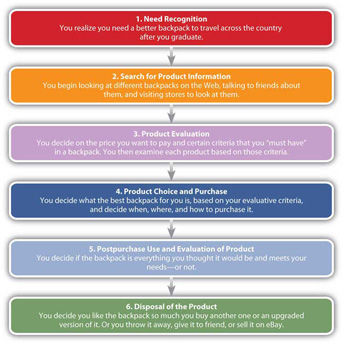This is “The Consumer’s Decision-Making Process”, section 3.1 from the book Marketing Principles (v. 1.0). For details on it (including licensing), click here.
For more information on the source of this book, or why it is available for free, please see the project's home page. You can browse or download additional books there. To download a .zip file containing this book to use offline, simply click here.
3.1 The Consumer’s Decision-Making Process
Learning Objectives
- Understand what the stages of the buying process are.
- Distinguish between low-involvement buying decisions and high-involvement buying decisions.
You’ve been a consumer with purchasing power for much longer than you probably realize—since the first time you were asked which cereal or toy you wanted. Over the years, you’ve developed a systematic way you choose among alternatives, even if you aren’t aware of it. Other consumers follow a similar process. The first part of this chapter looks at this process. The second part looks at the situational, psychological, and other factors that affect what, when, and how people buy what they do.
Keep in mind, however, that different people, no matter how similar they are, make different purchasing decisions. You might be very interested in purchasing a Smart Car. But your best friend might want to buy a Ford 150 truck. Marketing professionals understand this. They don’t have unlimited budgets that allow them to advertise in all types of media to all types of people, so what they try to do is figure out trends among consumers. Doing so helps them reach the people most likely to buy their products in the most cost effective way possible.
Stages in the Buying Process
Figure 3.2 "Stages in the Consumer’s Purchasing Process" outlines the buying stages consumers go through. At any given time, you’re probably in some sort of buying stage. You’re thinking about the different types of things you want or need to eventually buy, how you are going to find the best ones at the best price, and where and how will you buy them. Meanwhile, there are other products you have already purchased that you’re evaluating. Some might be better than others. Will you discard them, and if so, how? Then what will you buy? Where does that process start?
Figure 3.2 Stages in the Consumer’s Purchasing Process

Stage 1. Need Recognition
Perhaps you’re planning to backpack around the country after you graduate, but you don’t have a particularly good backpack. Marketers often try to stimulate consumers into realizing they have a need for a product. Do you think it’s a coincidence that Gatorade, Powerade, and other beverage makers locate their machines in gymnasiums so you see them after a long, tiring workout? Previews at movie theaters are another example. How many times have you have heard about a movie and had no interest in it—until you saw the preview? Afterward, you felt like had to see it.
Stage 2. Search for Information
Maybe you have owned several backpacks and know what you like and don’t like about them. Or, there might be a particular brand that you’ve purchased in the past that you liked and want to purchase in the future. This is a great position for the company that owns the brand to be in—something firms strive for. Why? Because it often means you will limit your search and simply buy their brand again.
If what you already know about backpacks doesn’t provide you with enough information, you’ll probably continue to gather information from various sources. Frequently people ask friends, family, and neighbors about their experiences with products. Magazines such as Consumer Reports or Backpacker Magazine might also help you.
Internet shopping sites such as Amazon.com have become a common source of information about products. Epinions.com is an example of consumer-generated review site. The site offers product ratings, buying tips, and price information. Amazon.com also offers product reviews written by consumers. People prefer “independent” sources such as this when they are looking for product information. However, they also often consult nonneutral sources of information, such advertisements, brochures, company Web sites, and salespeople.
Stage 3. Product Evaluation
Obviously, there are hundreds of different backpacks available to choose from. It’s not possible for you to examine all of them. (In fact, good salespeople and marketing professionals know that providing you with too many choices can be so overwhelming, you might not buy anything at all.) Consequently, you develop what’s called evaluative criteria to help you narrow down your choices.
Evaluative criteriaCertain characteristics of products consumers consider when they are making buying decisions. are certain characteristics that are important to you such as the price of the backpack, the size, the number of compartments, and color. Some of these characteristics are more important than others. For example, the size of the backpack and the price might be more important to you than the color—unless, say, the color is hot pink and you hate pink.
Figure 3.3

Osprey backpacks are known for their durability. The company has a special design and quality control center, and Osprey’s salespeople annually take a “canyon testing” trip to see how well the company’s products perform.
© 2010 Jupiterimages Corporation
Marketing professionals want to convince you that the evaluative criteria you are considering reflect the strengths of their products. For example, you might not have thought about the weight or durability of the backpack you want to buy. However, a backpack manufacturer such as Osprey might remind you through magazine ads, packaging information, and its Web site that you should pay attention to these features—features that happen to be key selling points of its backpacks.
Stage 4. Product Choice and Purchase
Stage 4 is the point at which you decide what backpack to purchase. However, in addition to the backpack, you are probably also making other decisions at this stage, including where and how to purchase the backpack and on what terms. Maybe the backpack was cheaper at one store than another, but the salesperson there was rude. Or maybe you decide to order online because you’re too busy to go to the mall. Other decisions, particularly those related to big ticket items, are made at this point. If you’re buying a high-definition television, you might look for a store that will offer you credit or a warranty.
Stage 5. Postpurchase Use and Evaluation
At this point in the process you decide whether the backpack you purchased is everything it was cracked up to be. Hopefully it is. If it’s not, you’re likely to suffer what’s called postpurchase dissonanceA situation in which consumers rethink their decisions after purchasing products and wonder if they made the best decision.. You might call it buyer’s remorse. You want to feel good about your purchase, but you don’t. You begin to wonder whether you should have waited to get a better price, purchased something else, or gathered more information first. Consumers commonly feel this way, which is a problem for sellers. If you don’t feel good about what you’ve purchased from them, you might return the item and never purchase anything from them again. Or, worse yet, you might tell everyone you know how bad the product was.
Companies do various things to try to prevent buyer’s remorse. For smaller items, they might offer a money back guarantee. Or, they might encourage their salespeople to tell you what a great purchase you made. How many times have you heard a salesperson say, “That outfit looks so great on you!”? For larger items, companies might offer a warranty, along with instruction booklets, and a toll-free troubleshooting line to call. Or they might have a salesperson call you to see if you need help with product.
Stage 6. Disposal of the Product
There was a time when neither manufacturers nor consumers thought much about how products got disposed of, so long as people bought them. But that’s changed. How products are being disposed is becoming extremely important to consumers and society in general. Computers and batteries, which leech chemicals into landfills, are a huge problem. Consumers don’t want to degrade the environment if they don’t have to, and companies are becoming more aware of the fact.
Take for example, Crystal Light, a water-based beverage that’s sold in grocery stores. You can buy it in a bottle. However, many people buy a concentrated form of it, put it in reusable pitchers or bottles, and add water. That way, they don’t have to buy and dispose of plastic bottle after plastic bottle, damaging the environment in the process. Windex has done something similar with its window cleaner. Instead of buying new bottles of it all the time, you can purchase a concentrate and add water. You have probably noticed that most grocery stores now sell cloth bags consumers can reuse instead of continually using and discarding of new plastic or paper bags.
Other companies are less concerned about conservation than they are about planned obsolescenceA deliberate effort by companies to make their products obsolete, or unusable, after a period of time.. Planned obsolescence is a deliberate effort by companies to make their products obsolete, or unusable, after a period of time. The goal is to improve a company’s sales by reducing the amount of time between the repeat purchases consumers make of products. When a software developer introduces a new version of product, older versions of it are usually designed to be incompatible with it. For example, not all the formatting features are the same in Microsoft Word 2003 and 2007. Sometimes documents do not translate properly when opened in the newer version. Consequently, you will be more inclined to upgrade to the new version so you can open all Word documents you receive.
Products that are disposable are another way in which firms have managed to reduce the amount of time between purchases. Disposable lighters are an example. Do you know anyone today that owns a nondisposable lighter? Believe it or not, prior to the 1960s, scarcely anyone could have imagined using a cheap disposable lighter. There are many more disposable products today than there were in years past—including everything from bottled water and individually wrapped snacks to single-use eye drops and cell phones.
Figure 3.4

Disposable lighters came into vogue in the United States in the 1960s. You probably don’t own a cool, nondisposable lighter like one of these, but you don’t have to bother refilling it with lighter fluid either.
© 2010 Jupiterimages Corporation
Low-Involvement versus High-Involvement Buying Decisions
Consumers don’t necessarily go through all the buying stages when they’re considering purchasing product. You have probably thought about many products you want or need but never did much more than that. At other times, you’ve probably looked at dozens of products, compared them, and then decided not to purchase any one of them. At yet other times, you skip stages 1 through 3 and buy products on impulse. As Nike would put, you “just do it.” Perhaps you see a magazine with Angelina Jolie and Brad Pitt on the cover and buy it on the spot simply because you want it. Purchasing a product with no planning or forethought is called impulse buyingPurchases that occurs with no planning or forethought..
Impulse buying brings up a concept called level of involvement—that is, how personally important or interested you are in consuming a product. For example, you might see a roll of tape at a check-out stand and remember you need one. Or you might see a bag of chips and realize you’re hungry. These are items you need, but they are low-involvement products. Low-involvement productsProducts that carry a low risk of failure and/or have a low price tag for a specific individual or group making the decision. aren’t necessarily purchased on impulse, although they can be. Low-involvement products are, however, inexpensive and pose a low risk to the buyer if she makes a mistake by purchasing them.
Consumers often engage in routine response behaviorWhen consumers make automatic purchase decisions based on limited information or information they have gathered in the past. when they buy low-involvement products—that is, they make automatic purchase decisions based on limited information or information they have gathered in the past. For example, if you always order a Diet Coke at lunch, you’re engaging in routine response behavior. You may not even think about other drink options at lunch because your routine is to order a Diet Coke, and you simply do it. If you’re served a Diet Coke at lunchtime, and it’s flat, oh well. It’s not the end of the world.
By contrast, high-involvement productsProducts that carry a high price tag or high level of risk to the individual or group making the decision. carry a high risk to buyers if they fail, are complex, or have high price tags. A car, a house, and an insurance policy are examples. These items are not purchased often. Buyers don’t engage in routine response behavior when purchasing high-involvement products. Instead, consumers engage in what’s called extended problem solvingPurchasing decisions in which a consumer gathers a significant amount of information before making a decision., where they spend a lot of time comparing the features of the products, prices, warrantees, and so forth.
High-involvement products can cause buyers a great deal of postpurchase dissonance if they are unsure about their purchases. Companies that sell high-involvement products are aware of that postpurchase dissonance can be a problem. Frequently, they try to offer consumers a lot of information about their products, including why they are superior to competing brands and how they won’t let the consumer down. Salespeople are typically utilized to do a lot of customer “hand-holding.”
Figure 3.5

Allstate’s “You’re in Good Hands” advertisements are designed to convince consumers that the insurance company won’t let them down.
© 2010 Jupiterimages Corporation
Limited problem solving falls somewhere in the middle. Consumers engage in limited problem solvingPurchasing decisions made based on consideration of some outside information. when they already have some information about a good or service but continue to search for a bit more information. The backpack you’re looking to buy is an example. You’re going to spend at least some time looking for one that’s decent because you don’t want it to fall apart while you’re traveling and dump everything you’ve packed on a hiking trail. You might do a little research online and come to a decision relatively quickly. You might consider the choices available at your favorite retail outlet but not look at every backpack at every outlet before making a decision. Or, you might rely on the advice of a person you know who’s knowledgeable about backpacks. In some way you shorten the decision-making process.
Brand names can be very important regardless of the consumer’s level of purchasing involvement. Consider a low- versus high-involvement product—say, purchasing a tube of toothpaste versus a new car. You might routinely buy your favorite brand of toothpaste, not thinking much about the purchase (engage in routine response behavior), but not be willing to switch to another brand either. Having a brand you like saves you “search time” and eliminates the evaluation period because you know what you’re getting.
When it comes to the car, you might engage in extensive problem solving but, again, only be willing to consider a certain brands or brands. For example, in the 1970s, American-made cars had such a poor reputation for quality, buyers joked that a car that’s “not Jap [Japanese made] is crap.” The quality of American cars is very good today, but you get the picture. If it’s a high-involvement product you’re purchasing, a good brand name is probably going to be very important to you. That’s why the makers of high-involvement products can’t become complacent about the value of their brands.
Video Clip
1970s American Cars
(click to see video)Today, Lexus is the automotive brand that experiences the most customer loyalty. For a humorous, tongue-in-cheek look at why the brand reputation of American carmakers suffered in the 1970s, check out this clip.
Key Takeaway
Consumer behavior looks at the many reasons why people buy things and later dispose of them. Consumers go through distinct buying phases when they purchases products: (1) realizing the need or want something, (2) searching for information about the item, (3) evaluating different products, (4) choosing a product and purchasing it, (5) using and evaluating the product after the purchase, and (6) disposing of the product. A consumer’s level of involvement is how interested he or she is in buying and consuming a product. Low-involvement products are usually inexpensive and pose a low risk to the buyer if she makes a mistake by purchasing them. High-involvement products carry a high risk to the buyer if they fail, are complex, or have high price tags. Limited-involvement products fall somewhere in between.
Review Questions
- What is consumer behavior? Why do companies study it?
- What stages do people go through in the buying process?
- How do low-involvement products differ from high-involvement products in terms of the risks their buyers face? Name some products in each category that you’ve recently purchased.




